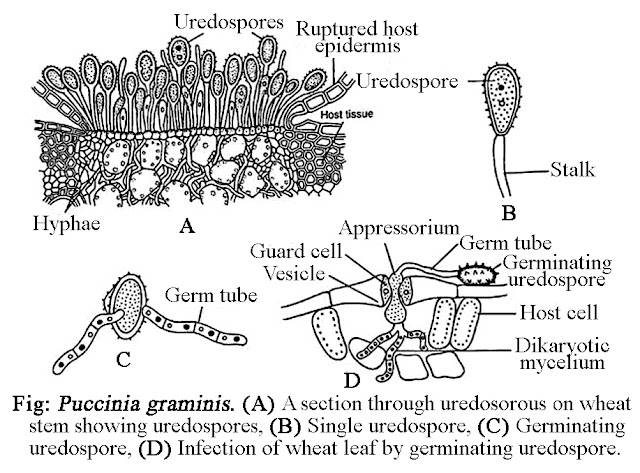CERCOSPORA - CLASSIFICATION, VEGETATIVE STRUCTURE, REPRODUCTION
A. CLASSIFICATION:
Division
– Mycota
Sub-division – Eumycotina
Class – Deuteromycetes
Order –
Moniliales
Family
– Dematiaceae
Genus
– Cercospora
The
genus Cercospora includes about 3800
species. Majority of the species are plant pathogens which cause leaf spot
diseases of higher plants of economic value. Commonly the leaf spot disease is
called the tikka disease. C. personata
and C. arachidicola are of two commonly
known form-species which is responsible for the leaf spot disease of groundnut.
B. STRUCTURE OF
THE VEGETATIVE BODY:- The mycelium in many species (C. personata) is entirely internal. The
hyphae ramify in the intercellular spaces between the mesophyll cells of the
host leaf obtaining nutrition by sending branched haustoria into the spongy and
palisade cells. In some form species (C.
arachidicola) the mycelium consists of both external and internal hyphae.
The later in the beginning are intercellular but later on become intracellular.
They do not produce haustoria. Before the mycelium enters the reproductive
phase, the hyphae accumulate and become compacted to form brown to black
globular mass of hyphae, the stroma immediately beneath the epidermis of the
host leaf in a sub-stomatal cavity.
C. REPRODUCTION:-
The perfect
stage in Cercospora is rare. However,
perfect stage is observed in C. personata
and C. arachidicola. It is Microsphaerella berkleyi in the former.
Reproduction
generally takes place by means of long, cylindrical, usually hyaline,
multiseptate conidia, which are produced at the tip of unbranched, dark
conidiophores. The later arise in tufts from a stroma lying in a sub-stomatal
cavity and emerge by rupturing the overlying epidermis. The conidiophores are
geniculate (knee-jointed) and 1-2 septate. The conidium, as it falls off leaves
a scar on the conidiophore.
****************




Comments
Post a Comment